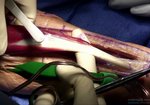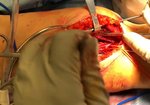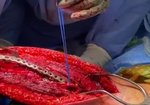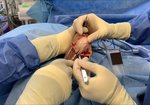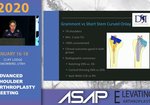Video Player is loading.
Current Time 0:00
/
Duration 0:00
Loaded: 0%
Stream Type LIVE
Remaining Time -0:00
1x
- 0.5x
- 0.75x
- 1x, selected
- 1.25x
- 1.5x
- 1.75x
- 2x
- Chapters
- descriptions off, selected
- captions settings, opens captions settings dialog
- captions off, selected
This is a modal window.
Beginning of dialog window. Escape will cancel and close the window.
End of dialog window.
10 seconds
Playback speed
This is a modal window. This modal can be closed by pressing the Escape key or activating the close button.
Anterior minimally invasive bridge-plate technique for treatment of humeral shaft nonunion
1,787 views
July 15, 2012
The present video introduces a new surgical technique for treating patients with humeral shaft nonunion. ...
read more ↘
Patients were operated by a bridge-plate technique. A 4.5-mm plate is slid on the anterior surface of the humerus, submuscular to the brachial muscle. With the plate over the anterior surface of the humerus, screws are inserted from anterior to posterior on the ends of the plate. When there is a small bone gap, an iliac autologous graft is inserted.
The present technique avoids wide dissection, radial nerve isolation, and periosteum stripping. The
anterior minimally invasive bridge-plate technique for treatment of humeral shaft nonunion is a safe procedure
and obtained bone healing in all patients in the series.
Original publication is available at: http://www.springerlink.com/content/1272v9582200521u/fulltext.pdf
A preliminar study is available at: http://www.mapfre.com/fundacion/html/revistas/trauma/v22n3/pdf/02_05.pdf
↖ read less
read more ↘
Patients were operated by a bridge-plate technique. A 4.5-mm plate is slid on the anterior surface of the humerus, submuscular to the brachial muscle. With the plate over the anterior surface of the humerus, screws are inserted from anterior to posterior on the ends of the plate. When there is a small bone gap, an iliac autologous graft is inserted.
The present technique avoids wide dissection, radial nerve isolation, and periosteum stripping. The
anterior minimally invasive bridge-plate technique for treatment of humeral shaft nonunion is a safe procedure
and obtained bone healing in all patients in the series.
Original publication is available at: http://www.springerlink.com/content/1272v9582200521u/fulltext.pdf
A preliminar study is available at: http://www.mapfre.com/fundacion/html/revistas/trauma/v22n3/pdf/02_05.pdf
↖ read less
Comments 4
Login to view comments.
Click here to Login

